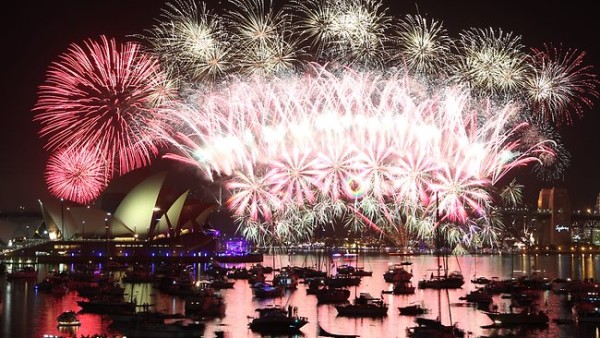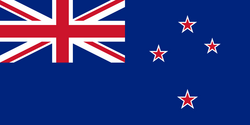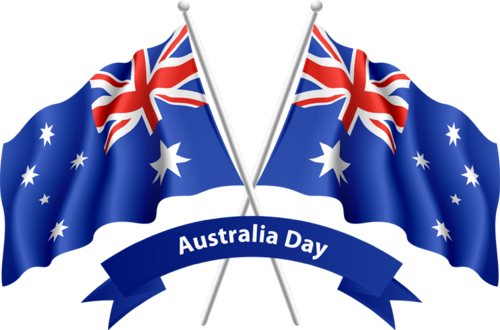-
Australia is more than 7 million km² big and there are 23 million inhabitants (France: 640.000 km² and 66 million inhabitants). The country is made up of six States (New South Wales, Western Australia, South Australia, Victoria, Queensland, Tasmania) and two Territories (Australian Capital Territory and Northern Territory).
This article is the first part of the theme “social rituals”. I will talk about national symbols and Australia Day in it. In another article, I will develop the Australian customs and some national events. Let's go!
The symbols
The flag
Here is the Australian Flag:
On the top left, there is the Union Jack, the flag of the United Kingdom. Indeed, Australia was discovered and colonised by the British, before becoming independent. Today, the country is still part of the Commonwealth, which includes former British colonies or protectorates.
Below the Union Jack, the white star is the Federation Star. There are 7 branches: 6 representing the States and one for the Australian Territories.
On the right side of the flag, there are 4 other white stars with 7 branches, and a smaller one with 5 branches only. Together, they represent the Southern Cross (or “Crux”), a constellation of the Southern hemisphere.
The Southern Cross is also present on other national flags: Brazil, Papua New Guinea, New Zealand.Brazil flag Papua New Guinea flag
New Zealand flag. It is very similar to Australia's one, but it is currently changing.
The Australian flag was adopted in 1901 by the monarch, and officially recognised as a national flag in 1954.
The arms
They are the official symbol of Australia. The arms were approved by George V in 1912.Melbourne Museum
The Federation Star is at the top. The shield is made of the symbols of the 6 States. It is held by a kangaroo and an emu (native Australian animals and national emblems) and supported by two branches of mimosa. These specific animals have a strong symbolic because they cannot retreat.
The national anthem
The Australian national anthem is called "Advance Australia Fair". It is the achievement of Peter Dodds McCormick and it is played since 1984. The Australian government wanted to break away from the British anthem "God Save the Queen." In 1973, they launched a competition so that Australian citizens choose their national anthem.
Here are the lyrics:♫ Australians all let us rejoice,
For we are young and free;
We've golden soil and wealth for toil,
Our home is girt by sea;
Our land abounds in Nature's gifts
Of beauty rich and rare;
In history's page, let every stage
Advance Australia fair !
In joyful strains then let us sing,
« Advance Australia fair! »
Beneath our radiant southern Cross,
We'll toil with hearts and hands;
To make this Commonwealth of ours
Renowned of all the lands;
For those who've come across the seas
We've boundless plains to share;
With courage let us all combine
To advance Australia fair.
In joyful strains then let us sing
« Advance Australia fair! » ♫
Most of the time, only the first stanza is played and sung. You can listen to this verison in the video below:
If you wish to hear the full version, click here.
The National Day: Australia Day
Australia Day is celebrated every 26th of January. It is very popular over there.
The date commemorates the arrival of the first European Fleet at Sydney Cove in 1788 and the proclamation of British sovereignty.
A website is dedicated to this day, where you can read the following:“On Australia Day we come together as a nation to celebrate what's great about Australia and being Australian. It's the day to reflect on what we have achieved and what we can be proud of in our great nation. It's the day for us to re-commit to making Australia an even better place for the future.
Though 26 January marks this specific event, today Australia Day celebrations reflect contemporary Australia: our diverse society and landscape, our remarkable achievements and our bright future. It also is an opportunity to reflect on our nation's history, and to consider how we can make Australia an even better place in future.
On Australia Day, over half of the nation’s population attend either an organised community event, or get together with family and friends with the intention of celebrating our national day.”
The 26th of January is a holiday in every State and Territory of Australia. Many festivities take place that day: citizenship ceremonies, concerts, community festivals, fireworks...

Australian citizens take the opportunity to picnic, watch sporting events on TV; in short, to relax.On that day, there are also the Australian of the Year Awards; they are for those who achieved great things for their country (much like the Legion of Honour in France).
That's it for the first part of the theme “social rituals”. I hope you’ve learned something (because I have!). Stay tuned for part 2! 1 commentaire
1 commentaire
-
By educating me about Australia, I heard a lot about Aboriginal people. This is a complex topic, though very interesting. Therefore, I decided to devote my free subject to Australia’s Aboriginal people. They are fully part of Australian culture and history.
Origins and culture
The Aboriginal culture is the oldest living culture in the world. Many mysteries surround Australian prehistory, but it is believed that the first humans settled in Australia more than 50,000 years ago and that they came from the Indonesian archipelago.
This semi-nomadic hunter-gatherer society was traditionally organised in tribes, themselves being composed of clans with a common ancestor. For its sustenance, the society relied on a thorough knowledge of the natural environment, utilising it extensively and sustainably.Capture and assimilation
Because of their tribal organisation, Aboriginal people could not resist European colonizers. This enabled the British to declare Australia terra nullius and to appropriate the territory. Indigenous were expelled, killed or herded into reserves where thousands of them died by contracting Western diseases.
From 1910 to the late 1960s, as part of a "cultural assimilation" policy, some 100,000 Aboriginal children, known as “the sacrificed generation", were forcibly removed from their families to be educated as white children.
In 1967, 90% of Australian voters said yes by referendum to Aboriginal voting rights.
A 2011 census determined a population of 670,000 Aboriginal people, accounting for 3% of the Australian population.
Nowadays, Aboriginal people are more affected by poverty than any other Australian group, and their life expectancy is less than 10 years the national average.
Tony Abbott, the former Australian Prime Minister, wanted to improve the Australian Aboriginal lives, but Malcolm Turnbull, the new one, did not say anything about this. So, to be continued…
Tony Abbott with Aboriginal people.
The Aboriginal Flag was created by Harold Thomas in 1971:
If you prefer video, I found an interesting one on the topic:
Link here.
See you!
 votre commentaire
votre commentaire Suivre le flux RSS des articles
Suivre le flux RSS des articles Suivre le flux RSS des commentaires
Suivre le flux RSS des commentaires









